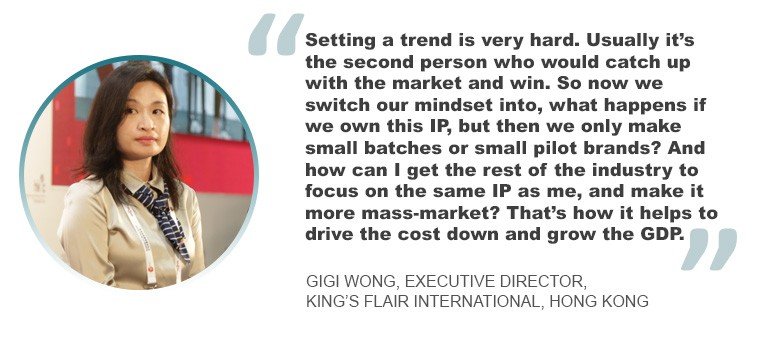BIP Asia: Experts share ideas about IP commercialization
31 January 2023

Owning intellectual property is one thing; making money from it is altogether different. Ivy Choi reports on discussions about IP commercialization from last year’s Business of IP Asia Forum.
During the Business of IP Asia Forum (BIP Asia) held at the Hong Kong Convention and Exhibition Centre on December 1-2, 2022, industry leaders from across the world assembled to share their insights on topics closely related to IP. One of the topics raised at the discussions was how to commercialize IP.

In a session titled “IP and Tech Commercialisation: Global Outlook and Insights for Hong Kong”, Heiwai Tang, director at Asia Global Institute of the University of Hong Kong, said that very often IP holders are not able to commercialize their IP because there is a lack of industrial capacity. There may also be a lack of institutions to transfer the legal rights of owning an IP into assets, such as financial products. In addition, he said that researchers who own patents often may not have the industry experience to understand what and where is the demand for their goods in the market.
“So if we can produce an IP trading centre with institutions and capacity to commercialize IP, then we can also facilitate the matching process between the supply of and demand for IPs in the industries.”
Tang explained that there are at least four kinds of IP commercialization. The first one is assignment. “When you acquire a company, the affiliate might already have some IPs, then the owner of the IPs can just assign the IPs to you, the new owner of the company.” The second one is licensing. “You pay a fee to the patent owner in order to gain the right to use the IP for a period of time. A lot of the companies in Hong Kong obviously are paying license fees to patent owners outside of Hong Kong.”
The third one is joint venture transfer between different affiliates of the same company. The last one is IP financing. “It requires financial institutions to allow companies to use IP, including patents, as collaterals when they go to borrow from a bank, let’s say, then their IP will be considered as their collaterals.”

Gigi Wong, executive director at King’s Flair International (Holdings) Limited, which is a kitchenware company, shared her experience of working with IPs from the industry perspective. She said that traditionally, people would think that IP registration was just about protecting its exclusive rights of manufacturing or distribution, so that no one else could get it. But things have changed. She said that nowadays the value of owning an IP, which might be new to the market, is to set a trend. “But setting a trend is very hard,” she said, as it is often for the first one making the new attempt to fail by putting in so much capital that they cannot get back. “Usually it’s the second person who would catch up with the market and win,” she said. “So now we switch our mindset into, what happens if we own this IP, but then we only make small batches or small pilot brands? And how can I get the rest of the industry to focus on the same IP as me, and make it more mass-market? That’s how it helps to drive the cost down and grow the GDP.”
Wong also shared some of the challenges her company faces in IP commercialization, especially when working with various parties. “I think every party represents their best interest in a project. So instead of running an internal design team and merchandising and manufacturing network, you start managing government, innovation institutions, and then universities with very different knowledge know-how, and how to make it work. So I think one of the biggest challenges we have is how to align everyone’s incentives together. We don’t want something that is just on paper, but we want something that is launched in all – the mass market, the retailers, and then the end-users, who get to benefit from it.”
It can be difficult to convey this goal to researchers, who are more interested in bringing significant game-changers to the industry than just making a small enhancement. But in reality, a game-changer often takes 10 years or more to develop, while the life span of a new product might be just one year. Having a business to run, Wong needs new features to be launched regularly, instead of waiting for years of research. How do you make a professor in the institution understand the urgency of the business environment? That is the challenge.
The second challenge is that IP ownership can be complex sometimes. For example, an IP may extend to multiple sub-IPs, and can be used across industries. “So how do you discuss with every single owner and try to differentiate the features from and the benefits of this IP, without contradicting and fighting with each other, and make the market pie bigger?”
According to Wong, the conversations involved in the above two challenges waste a lot of time and resources in negotiating, even just during the agreement phase. “We’re not even talking about going down the road – we haven’t even started yet.” Another thing that might be intimidating to industrialists in investing in IP commercialization is that not every IP is essentially a product ready for the market. “Some are theories, and some are just prototypes,” she shared her observations. “So it may be a great idea, but it’s not cost-effective. And then if no one is willing to pay for this usage or feature, and consumers don’t see the benefit of it, then it’s like a whole misalignment all the way. And I think that’s what scares a lot of our industrialists. If you put in a few million dollars, and you cannot get it out in two years, then what kind of business viability comes in?”
Finally, she suggested: “If we can refine the framework of how we work together, from government institutions to universities, and have more aligned goals, maybe it will help a lot in speeding up commercialization.”

While Tang and Wong shared the Hong Kong perspectives as an academic and an industrialist, in another discussion session titled “Powering the Future: Robust Patent Strategies Amid Challenges”, Brett Alten, senior vice president, deputy general counsel and chief IP counsel at Hewlett Packard Enterprise, had an interesting take on IP commercialization by referring to the situation in the United States. Instead of just relying on conventional IP assets, like patents, Alten pointed out that more companies are now adopting trade secrets as a core part of their IP strategies, especially within the tech community.
Alten said that in the U.S., it is possible to make a trade secret claim in both state court and federal court. While data from the state court show that there was only a slight increase in the number of trade secret claim cases over 15 years, in the federal court, on the other hand, there was an exponential rise from 1990 to 2010. “Even in the International Trade Commission, which is another way to enforce your rights, there were three times more trade secret-related investigations than there were five years ago, even though the total number of investigations remained relatively flat.”
“Interestingly, in 2016, the United States passed a law called the Defend Trade Secrets Act (DTSA),” he said. This law was focused on the fact that trade secrets can be easily spirited away beyond the reach of U.S. law, which was a concern of the legislatures. “There are recent cases that say, even if the misappropriation occurs outside the United States, U.S. law can still get you. Or maybe you have communications outside, and the misappropriation occurs on U.S. servers, which also allows us to find a right to file that claim. So the DTSA is a very important milestone in trade secret law, and it’s becoming a very important part of our practice.”
According to Alten, the number of DTSA filings is now 600 per year, which is consistently high, especially compared to data from state and federal courts in earlier years. “So it’s really interesting that companies are using this course of action very aggressively and more than ever in the past,” he said. “Now if you look at all the cases where trade secrets were filed in federal court, both state claims and the DTSA, there were already 1,253 cases filed just in 2021. And over 7,700 since the DTSA. Again, this supports the increasing importance of trade secrets.”
As trade secrets are gaining importance, trade secret loss is also becoming a bigger risk than ever, and Alten suggested that there are at least three reasons. The first reason is that more people are leaving their jobs. “The number one reason you get trade secret misappropriation is that an exiting employee brings that trade secret to their new employer,” he said. “Number two, more people are working at home, and it is harder to track and manage these trade secrets. And three, more people are relying on software inventions generally. Now many software inventions are very difficult to detect and are not reversible. You can’t easily reverse-engineer them, so many people are relying more on trade secrets to protect their software. And for all these reasons, we have to take trade secret risks much more seriously.”
Alten argued that sometimes trade secrets might be better than patents in protecting the owner’s benefits, contrary to traditional understanding. “While patents sort of create this illusion that you can have some exclusionary practice in the marketplace, in reality, once a technology is out there, people will copy it. So in some ways, by patenting, you’re accelerating your competitors’ position in the market. Trade secrets give you an unlimited length of time to hold it secret. You risk, of course, that you’ll lose the trade secret if it’s independently developed, or if there’s a misappropriation. But I think it’s important to note, you don’t get the benefit of patents usually, unless you assert your patent. And that’s years of waiting, and it’s very expensive and very risky.”
“I think as we try to commercialize IP generally, it’s becoming less interesting, at least in my experience, to try to monetize pure IP,” Alten said. “Trying to sell patents is difficult. You can’t really make a lot of money by selling patents, especially for a large corporation. It’s often immaterial. It’s a way to cut costs, or pay some annuity fees, but it’s lumpy and the materiality of the revenue is generally quite low.”
A better alternative to patent sales seems to be patent licensing, but it has its own problems too. “It’s recurring revenue, but the problem with licensing is that no one wants to pay. So it’s often adversarial. You have to be willing to fight for your money. And if you’re an operating company, that often conflicts with your operating company, with your customers, with your supply chain, so you need to be very careful.”
“I think we’re moving towards the future where technology transfer is really a more stable and more material way of commercializing IP,” he said. “It is friendly; it’s recurring revenue; it supports your own R&D team; it drives the adoption of your technology on which you can differentiate; and it actually helps you get closer to your customers, because they like to know that you’re working with them in the technological spaces.”






